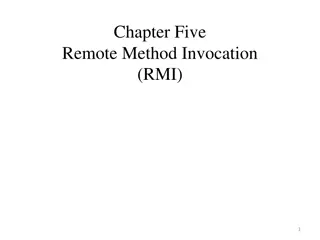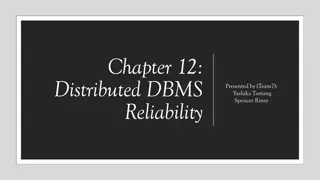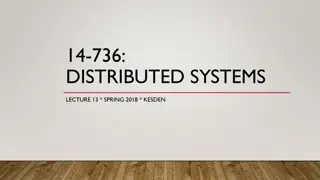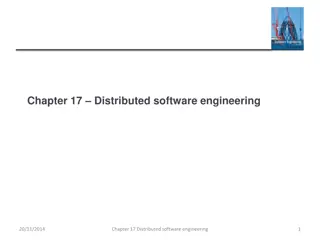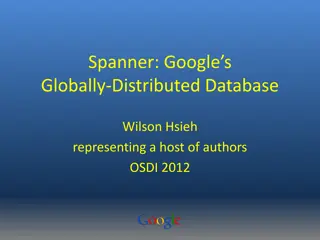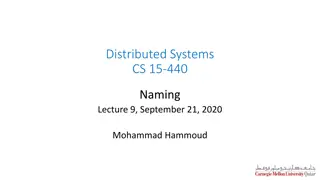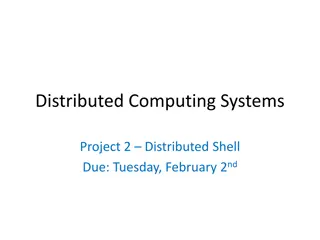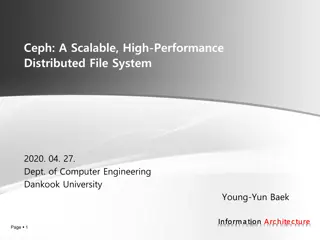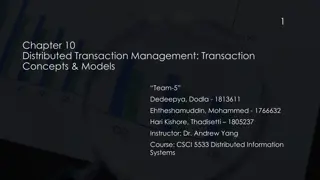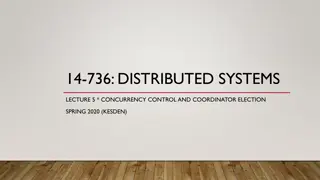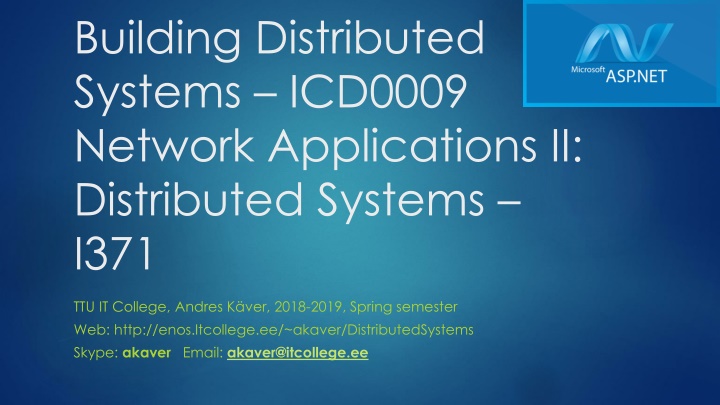
Distributed Systems and Network Applications II Overview
"Explore the architectural principles, service models, and web technologies in building distributed systems for effective communication and data exchange. Learn the significance of services, web protocols, and HTTP requests in a distributed environment."
Download Presentation

Please find below an Image/Link to download the presentation.
The content on the website is provided AS IS for your information and personal use only. It may not be sold, licensed, or shared on other websites without obtaining consent from the author. If you encounter any issues during the download, it is possible that the publisher has removed the file from their server.
You are allowed to download the files provided on this website for personal or commercial use, subject to the condition that they are used lawfully. All files are the property of their respective owners.
The content on the website is provided AS IS for your information and personal use only. It may not be sold, licensed, or shared on other websites without obtaining consent from the author.
E N D
Presentation Transcript
Building Distributed Systems ICD0009 Network Applications II: Distributed Systems I371 TTU IT College, Andres K ver, 2018-2019, Spring semester Web: http://enos.Itcollege.ee/~akaver/DistributedSystems Skype: akaver Email: akaver@itcollege.ee
Distributed Typical app architecture 1 APPLICATION DATABASE
Distributed App Architecture 2 APPLICATION SERVICE APPLICATION BUSINESS LOGIC LAYER DATA ACCESS LAYER DATABASE
Distributed - Service 3 Why service Database changes, underlaying business rule changes Data access is expensive Possibility to divide functionality between different platforms Future proof (versioning) Authentication and authorization
Distributed - WebService 4 W3C XML Protocol Working Group Charter Today, the principal use of the World Wide Web is for interactive access to documents and applications. In almost all cases, such access is by human users, typically working through Web browsers, audio players, or other interactive front-end systems. The Web can grow significantly in power and scope if it is extended to support communication between applications, from one program to another. T.Tammet Laiemas m ttes t hendab "veebiteenus" n harilikku veebi, selle erinevusega, et urlide avamist ja vormide t itmist teeb programm, ning tulemusi loeb ja kasutab samuti programm, mitte inimene. Teisis nu, "veebiteenus" t hendab programmide omavahelist suhtlemist ja andmevahetust le hariliku veebi.
Distributed - WebService 5 So it is based on regular web (mostly). REST is based on HTTP, SOAP can use several different transport protocols. So far, you have mostly used GET and POST requests There are also available several other request types: PUT, DELETE, PATCH, OPTIONS, RESTful uses GET Lookup PUT Mutation POST Creation DELETE - Deletion
Distributed HTTP - GET 6 HTTP is purely text based protocol, basically you are just sending bunch of key-value pairs from browser to server GET https://localhost:44363/People/Create HTTP/1.1 Host: localhost:44363 Connection: keep-alive Upgrade-Insecure-Requests: 1 User-Agent: Mozilla/5.0 (Windows NT 10.0; Win64; x64) AppleWebKit/537.36 (KHTML, like Gecko) Chrome/71.0.3578.98 Safari/537.36 Accept: text/html,application/xhtml+xml,application/xml;q=0.9,image/webp,image/apng,*/*;q=0.8 Referer: https://localhost:44363/People Accept-Encoding: gzip, deflate, br Accept-Language: en-US,en;q=0.9,et;q=0.8 Cookie: _ga=GA1.1.1433392067.1524809543;
Distributed HTTP GET - response 7 HTTP/1.1 200 OK Cache-Control: no-cache, no-store Pragma: no-cache Content-Type: text/html; charset=utf-8 Server: Microsoft-IIS/10.0 X-SourceFiles: =?UTF- 8?B?QzpcVXNlcnNcYWthdmVyXHNvdXJjZVxyZXBvc1xIVFRQVGVzdFxXZWJBcHBcUGVvcGxlXENy ZWF0ZQ==?= X-Powered-By: ASP.NET Date: Sat, 26 Jan 2019 12:24:13 GMT Content-Length: 3367 <!DOCTYPE html> <html> <head> <meta charset="utf-8" /> <meta name="viewport" content="width=device-width, initial-scale=1.0" /> <title>Create - WebApp</title>
Distributed HTTP - POST 8 POST https://localhost:44363/People/Create HTTP/1.1 Host: localhost:44363 Connection: keep-alive Content-Length: 194 Cache-Control: max-age=0 Origin: https://localhost:44363 Upgrade-Insecure-Requests: 1 Content-Type: application/x-www-form-urlencoded User-Agent: Mozilla/5.0 (Windows NT 10.0; Win64; x64) AppleWebKit/537.36 (KHTML, like Gecko) Chrome/71.0.3578.98 Safari/537.36 Accept: text/html,application/xhtml+xml,application/xml;q=0.9,image/webp,image/apng,*/*;q=0.8 Referer: https://localhost:44363/People/Create Accept-Encoding: gzip, deflate, br Accept-Language: en-US,en;q=0.9,et;q=0.8 Cookie: _ga=GA1.1.1433392067.1524809543; Name=Andres&__RequestVerificationToken=CfDJ8JXfYWVYzpxPgG_38dOFAzHQGkoaDtNMXtzBr3vNUF UDOYe7XT_ueh6IMyEfRXYWTTOvd2Bjm8gxjOwN8jRBGngeIIKZmnJB- xD4Wvd1enqy0M5GrgAWVgAOg0vZPgHNzvIYDBTmwJqi3L2WYM-5mm4
Distributed HTTP- POST - response 9 HTTP/1.1 302 Found Location: /People Server: Microsoft-IIS/10.0 X-SourceFiles: =?UTF- 8?B?QzpcVXNlcnNcYWthdmVyXHNvdXJjZVxyZXBvc1xIVFRQV GVzdFxXZWJBcHBcUGVvcGxlXENyZWF0ZQ==?= X-Powered-By: ASP.NET Date: Sat, 26 Jan 2019 12:17:16 GMT Content-Length: 0
Distributed HTTP response codes 10 1xx Informational response 100 continue, 101 switching protocols 2xx Success 200 OK, 201 Created, 202 Accepted, 204 No Content 3xx Redirection 300 Multiple choices, 301 Moved Permanently, 302 Found, 303 See other, 304 Not Modified 4xx Client errors 400 Bad Request, 401 Unauthorized, 403 Forbidden, 404 Not Found, 409 Conflict 5xx Server errors 500 Internal Server Error, 501 Not implemented, 503 Service Unavailable
Distributed RESTful service/api 11 REST - Representational State Transfer It s an architectural style that defines a set of recommendations for designing loosely coupled applications that use the HTTP protocol for data transmission. REST doesn t prescribe how to implement the principles at a lower level. Instead, the REST guidelines allow developers to implement the details according to their own needs. Web services built following the REST architectural style are called RESTful web services.
Distributed RESTful services 12 Six architectural constraints Uniform interface Requests from different clients should look the same, for example, the same resource shouldn t have more than one URI. Client-server separation The client and the server should act independently. They should interact with each other only through requests and responses. Statelessness There shouldn t be any server-side sessions. Each request should contain all the information the server needs to know.
Distributed RESTful services 13 Cacheable resources Server responses should contain information about whether the data they send is cacheable or not. Cacheable resources should arrive with a version number so that the client can avoid requesting the same data more than once. Layered system There might be several layers of servers between the client and the server that returns the response. This shouldn t affect either the request or the response. Code on demand [optional] When it s necessary, the response can contain executable code (e.g., JavaScript within an HTML response) that the client can execute.
Distributed REST vs SOAP 14 REST makes data available as resources (e.g. user) SOAP makes data available via services (e.g. getUser) SOAP Simple Object Access Protocol SOAP can work with any application layer protocol, such as HTTP, SMTP, TCP, or UDP. It returns data to the receiver in XML format. Security, authorization, and error-handling are built into the protocol
Distributed - SOAP 15 Currently, SOAP will likely continue to be used for big enterprise-level web services that require high security and complex transactions. APIs for financial services, payment gateways, CRM software, identity management, and telecommunication services are commonly used examples of SOAP. One of the most well known SOAP APIs is PayPal s public API that allows you to accept PayPal and credit card payments, add a PayPal button to your website, let users log in with PayPal, and perform other PayPal-related actions. Estonian SOAP services: X-Tee, DigiDoc
Distributed Whats the plan? 16 We will start with REST based services as more modern approach. At the end of semester, some SOAP and XML Good reading: How I Explained REST to My Wife http://web.archive.org/web/20130116005443/http://tomayko.com/ writings/rest-to-my-wife
Distributed 17 Tooling needed at first .NET Core and ASP.NET Core JetBrains Rider Main IDE Postman for REST testing Node and NPM for frontend client development Aurelia as frontend framework (or choose your own Angular, Ember, Polymer) or not-so-full-framework (React, Vue) or use barebones approach and write plain JS (and some jQuery) TypeScript on top of JS highly recommended (mandatory in Angular)



